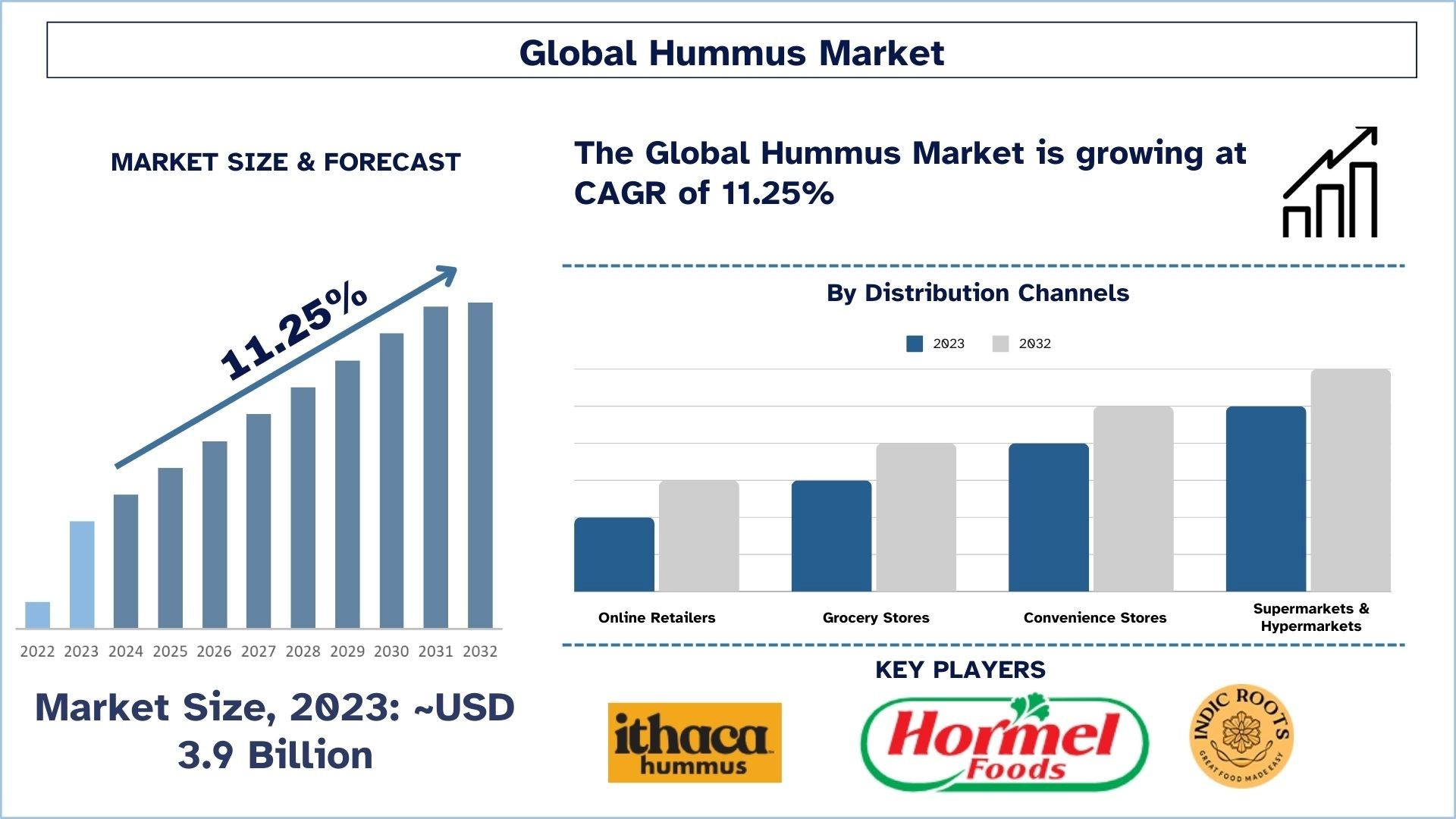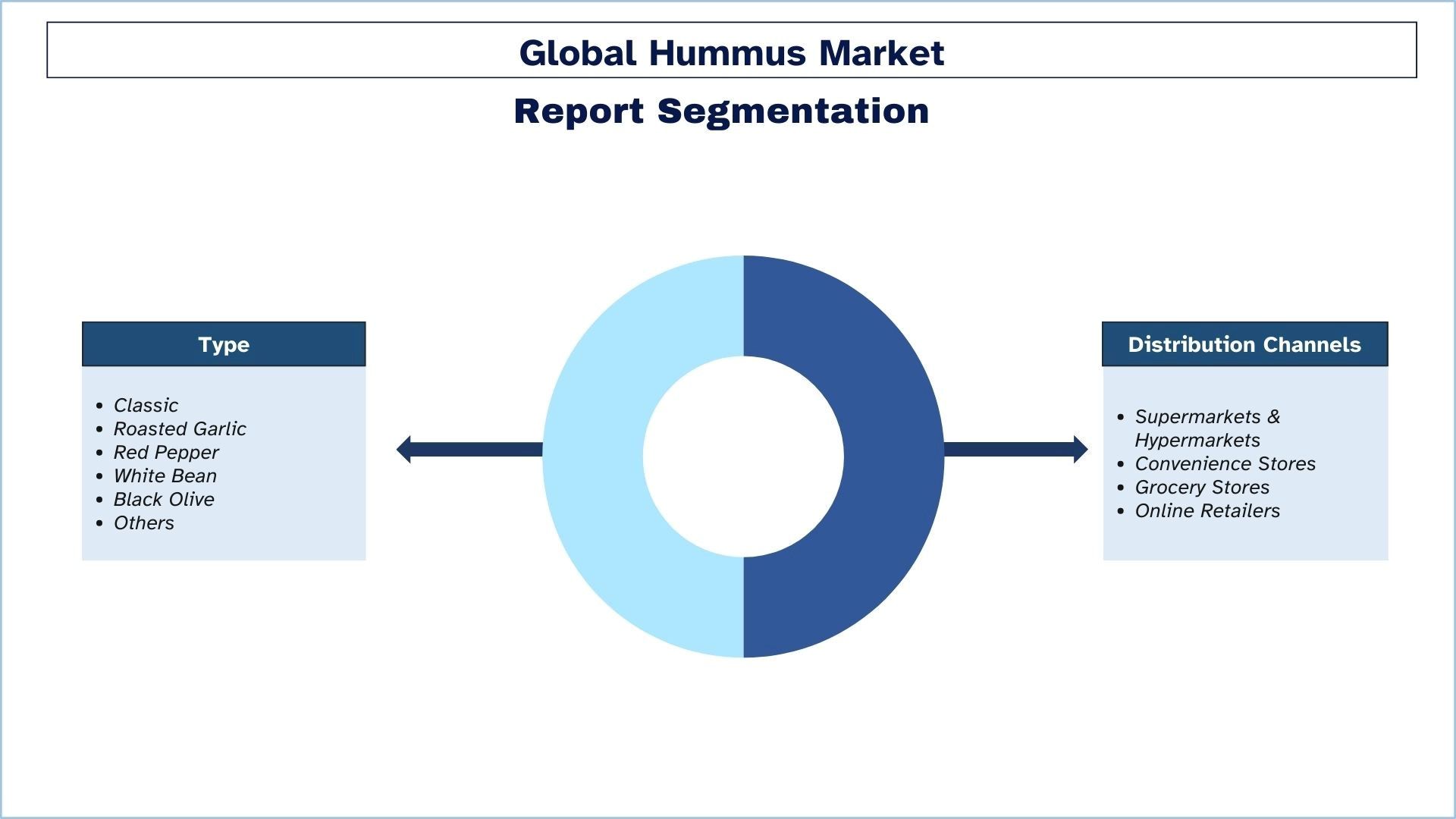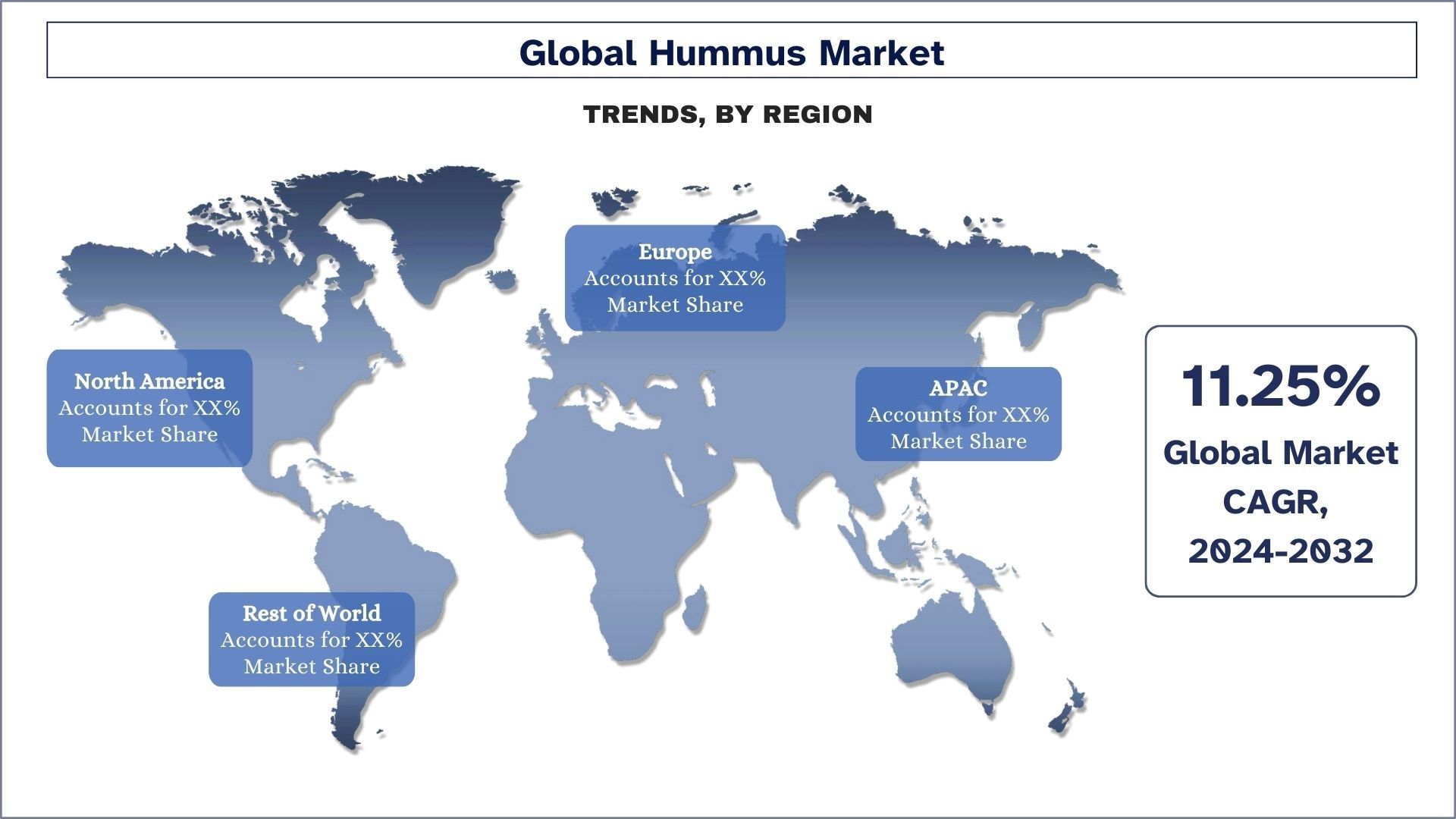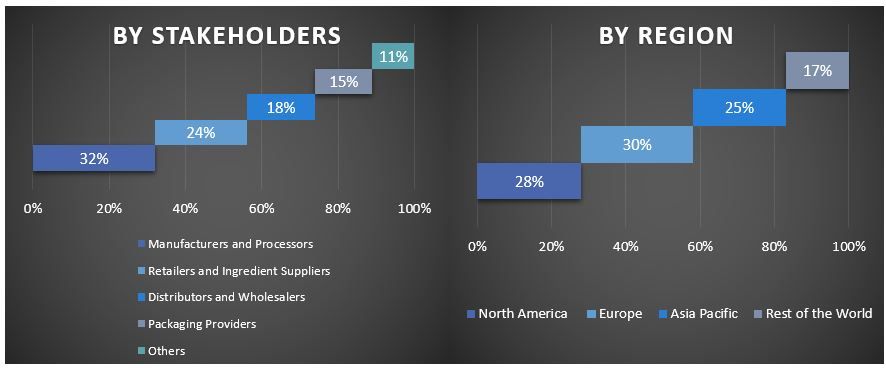- Home
- About Us
- Industry
- Services
- Reading
- Contact Us
Hummus Market: Current Analysis and Forecast (2024-2032)
Emphasis on Type (Classic, Roasted Garlic, Red Pepper, White Bean, Black Olive, and Others); Distribution Channels (Supermarkets & Hypermarkets, Convenience Stores, Grocery Stores, and Online Retailers); and Region/Country

Global Hummus Market Size & Forecast
The Global Hummus Market was valued at USD 3.9 billion in 2023 and is expected to grow at a strong CAGR of around 11.25% during the forecast period (2024-2032) owing to the promotion of healthy, trendy foods on social media platforms.
Hummus Market Analysis
The hummus market involves both manufacturing and marketing of hummus, which is a creamy dip prepared from chickpeas, tahini, olive oil, lemon juice, and garlic with numerous nutritive values and culinary uses. Hummus has grown popular all over the world because of current dietary requirements, especially those that comprise plant protein and the tendencies towards natural foods that have little to no processing. This popularity is further seen especially in regions such as North America and Europe where labeled hummus is consumed in homes and food service settings. Since more people look for tasty and easy-to-prepare food that suits multiple diets, hummus maintains robust trends.
Global Hummus Market Trends
This section discusses the key market trends that are influencing the various segments of the global Hummus market, as found by our team of research experts.
Supermarkets & Hypermarkets Segment Transforming Industry
The supermarkets & hypermarkets segment is a key driver of the hummus market. because of their accessibility and affordable prices particularly northwest of the globe. Supermarkets and hypermarkets offer product visibility facilitate Interbrand, inter competition, and promote impulse buying. Also, supermarkets place hummus in the chilled plant-based food area targeting vegan and health-conscious customers. These formats are also conducive to promotional activity since brands can extend the trial of new products such as flavors through taste tests and point-of-sale placements.

North America is expected to grow at a significant rate during the forecast period.
The North American Hummus market is likely to expand in the coming years because of the growing demand for healthy and protein products. Hummus is classified as high in fiber and high in protein making it fit the above dietary goals and thus is suitable for those clients who are embracing plant-based diets. Another boost to the shift of this product to America’s and Canada’s kitchens is the current fascination with Mediterranean food.

Global Hummus Industry Overview
The global hummus market is competitive, with several global and international market players. The key players are adopting different growth strategies to enhance their market presence, such as partnerships, agreements, collaborations, new product launches, geographical expansions, and mergers and acquisitions. Some of the major players in the market are CEDAR’S MEDITERRANEAN FOODS, INC.; Haliburton International Foods, Inc.; Danone (Strauss Group); Savencia SA (Hope Foods, LLC); Fountain of Health; Hummus Goodness; Fontaine Santé (Lantana Foods); Hormel Foods Corporation; Indic Roots; Ithaca Hummus
Global Hummus Market Report Coverage
Report Attribute | Details |
Base year | 2023 |
Forecast period | 2024-2032 |
Growth momentum | Accelerate at a CAGR of 11.25% |
Market size 2023 | USD 3.9 billion |
Regional analysis | North America, Europe, APAC, Rest of the World |
Major contributing region | North America is expected to dominate the market during the forecasted period. |
Key countries covered | U.S., Canada, Germany, U.K., Spain, Italy, France, China, Japan, and India |
Companies profiled | CEDAR’S MEDITERRANEAN FOODS, INC.; Haliburton International Foods, Inc.; Danone (Strauss Group); Savencia SA (Hope Foods, LLC); Fountain of Health; Hummus Goodness; Fontaine Santé (Lantana Foods); Hormel Foods Corporation; Indic Roots; Ithaca Hummus |
Report Scope | Market Trends, Drivers, and Restraints; Revenue Estimation and Forecast; Segmentation Analysis; Demand and Supply Side Analysis; Competitive Landscape; Company Profiling |
Segments Covered | By Type; By Distribution Channels; By Region/Country |
Reasons to buy this report:
The study includes market sizing and forecasting analysis confirmed by authenticated key industry experts.
The report briefly reviews overall industry performance at one glance.
The report covers an in-depth analysis of prominent industry peers, primarily focusing on key business financials, type portfolios, expansion strategies, and recent developments.
Detailed examination of drivers, restraints, key trends, and opportunities prevailing in the industry.
The study comprehensively covers the market across different segments.
Deep dive regional level analysis of the industry.
Customization Options:
The global hummus market can further be customized as per the requirement or any other market segment. Besides this, UMI understands that you may have your own business needs, hence feel free to contact us to get a report that completely suits your requirements.
Table of Content
Research Methodology for the Global Hummus Market Analysis (2024-2032)
Analyzing the historical market, estimating the current market, and forecasting the future market of the global Hummus market were the three major steps undertaken to create and analyze the adoption of the global Hummus in major regions. Exhaustive secondary research was conducted to collect the historical market figures and estimate the current market size. Secondly, to confirm these insights, numerous findings and assumptions were considered. Moreover, exhaustive primary interviews were conducted with industry experts across the value chain of the global Hummus market. For the assumption and validation of market numbers through primary interviews, we employed a top-down/bottom-up approach to forecasting the complete market size. Thereafter, market breakdown and data triangulation methods were adopted to estimate and analyze the market size of segments and sub-segments of the industry. The detailed method is explained below:
Analysis of Historical Market Size
Step 1: In-Depth Study of Secondary Sources:
A detailed secondary study was conducted to obtain the historical market size of the global Hummus market through company internal sources such as annual reports & financial statements, performance presentations, press releases, etc., and external sources including journals, news & articles, government publications, competitor publications, sector reports, third-party database, and other credible publications.
Step 2: Market Segmentation:
After obtaining the historical market size of the global Hummus market, we conducted a detailed secondary analysis to gather historical market insights and share for different segments & sub-segments for major regions. Major segments are included in the report, such as type, distribution channels, and region. Further country-level analysis were conducted to evaluate the overall adoption of testing models in that region.
Step 3: Factor Analysis:
After buying the historical market size of different segments and sub-segments, we conducted a detailed factor analysis to estimate the current market size of the global Hummus market. Further, we conducted factor analysis using dependent and independent variables such as type, distribution channels, and global Hummus market regions. A thorough analysis of demand and supply-side scenarios was conducted considering top partnerships, mergers and acquisitions, business expansion, and product launches in the global Hummus market.
Current Market Size Estimate & Forecast
Current Market Sizing: Based on actionable insights from the above 3 steps, we arrived at the current market size, key players in the global Hummus market, and market shares of the segments. All the required percentage shares split and market breakdowns were decided using the above-mentioned secondary approach and were verified through primary interviews.
Estimation & Forecasting: For market estimation and forecast, weights were assigned to several factors including drivers & trends, restraints, and opportunities available for the stakeholders. After analyzing these factors, relevant forecasting techniques, i.e., the top-down/bottom-up approach were applied to arrive at the market forecast of 2032 for different segments and sub-segments across the major markets globally. The research method adopted to estimate the market size encompasses:
The industry’s market size, in terms of revenue (USD) and the adoption rate of the global Hummus market across the major markets domestically
All percentage shares, splits, and breakdowns of market segments and sub-segments
Key players in the global Hummus market in terms of types offered. Also, the growth strategies adopted by these players to compete in the fast-growing market.
Market Size and Share Validation
Primary Research: In-depth interviews were conducted with the Key Opinion Leaders (KOLs) including Top Level Executives (CXO/VPs, Sales Head, Marketing Head, Operational Head, Regional Head, Country Head, etc.) across major regions. Primary research findings were then summarized, and statistical analysis was performed to prove the stated hypothesis. Inputs from primary research were combined with secondary findings, hence turning information into actionable insights.
Split of Primary Participants in Different Regions

Market Engineering
The data triangulation technique was employed to complete the overall market estimation and to arrive at precise statistical numbers for each segment and sub-segment of the global Hummus market. Data was split into several segments and sub-segments after studying various parameters and trends in the global Hummus market's type, distribution channels, and regions.
The Main Objective of the Global Hummus Market Study
The current & future market trends of the global Hummus market were pinpointed in the study. Investors can gain strategic insights to base their discretion for investments on the qualitative and quantitative analysis performed in the study. Current and future market trends determined the market's overall attractiveness at a regional level, providing a platform for the industrial participant to exploit the untapped market to receive help from a first-mover advantage. Other quantitative goals of the studies include:
Analyze the current forecast and market size of the global Hummus market in terms of value (USD). Also, analyze the current forecast and market size of different segments and sub-segments.
Segments in the study include areas of type, distribution channels, and regions.
Define and analyze the regulatory framework for the industry.
Analyze the value chain involved with the presence of various intermediaries, along with analyzing customer and competitor behaviors of the industry.
Analyze the current and forecast market size of the global Hummus market for the major regions.
Major countries of regions studied in the report include Asia Pacific, Europe, North America, and the Rest of the World
Company profiles of the global Hummus market and the growth strategies the players adopt to sustain the fast-growing market.
Deep dive regional level analysis of the industry
Frequently Asked Questions FAQs
Q1: What is the global Hummus market’s current market size and growth potential?
The global hummus market was valued at USD 3.9 billion in 2023 and is expected to grow at a CAGR of 11.25% during the forecast period (2024-2032).
Q2: What are the driving factors for the growth of the global Hummus market?
Organic hummus options are in demand, driven by consumer interest in clean-label and natural products.
Q3: Which segment has the largest global Hummus market share by type category?
The classic category has the largest share of the global hummus market by type segment.
Q4: What are the emerging technologies and trends in the global hummus market?
Growth in single-serve packaging aligns with consumer demand for portion control and convenience.
Q5: Which regions dominate the global Hummus market?
North America is expected to dominate the market during the forecast period.
Related Reports
Customers who bought this item also bought










